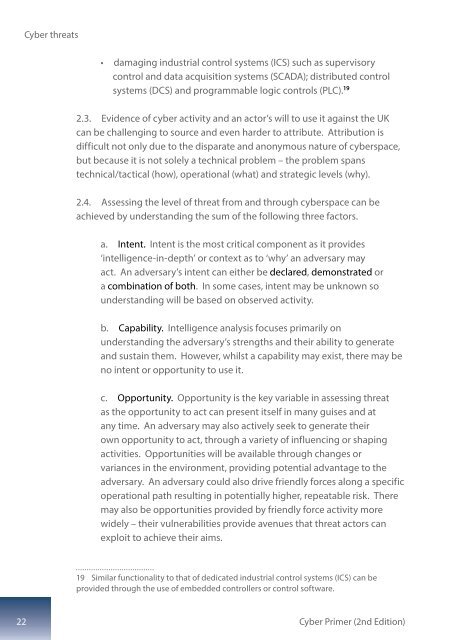Cyber Primer
AEWhbF
AEWhbF
Create successful ePaper yourself
Turn your PDF publications into a flip-book with our unique Google optimized e-Paper software.
<strong>Cyber</strong> threats<br />
• damaging industrial control systems (ICS) such as supervisory<br />
control and data acquisition systems (SCADA); distributed control<br />
systems (DCS) and programmable logic controls (PLC). 19<br />
2.3. Evidence of cyber activity and an actor’s will to use it against the UK<br />
can be challenging to source and even harder to attribute. Attribution is<br />
difficult not only due to the disparate and anonymous nature of cyberspace,<br />
but because it is not solely a technical problem – the problem spans<br />
technical/tactical (how), operational (what) and strategic levels (why).<br />
2.4. Assessing the level of threat from and through cyberspace can be<br />
achieved by understanding the sum of the following three factors.<br />
a. Intent. Intent is the most critical component as it provides<br />
‘intelligence-in-depth’ or context as to ‘why’ an adversary may<br />
act. An adversary’s intent can either be declared, demonstrated or<br />
a combination of both. In some cases, intent may be unknown so<br />
understanding will be based on observed activity.<br />
b. Capability. Intelligence analysis focuses primarily on<br />
understanding the adversary’s strengths and their ability to generate<br />
and sustain them. However, whilst a capability may exist, there may be<br />
no intent or opportunity to use it.<br />
c. Opportunity. Opportunity is the key variable in assessing threat<br />
as the opportunity to act can present itself in many guises and at<br />
any time. An adversary may also actively seek to generate their<br />
own opportunity to act, through a variety of influencing or shaping<br />
activities. Opportunities will be available through changes or<br />
variances in the environment, providing potential advantage to the<br />
adversary. An adversary could also drive friendly forces along a specific<br />
operational path resulting in potentially higher, repeatable risk. There<br />
may also be opportunities provided by friendly force activity more<br />
widely – their vulnerabilities provide avenues that threat actors can<br />
exploit to achieve their aims.<br />
19 Similar functionality to that of dedicated industrial control systems (ICS) can be<br />
provided through the use of embedded controllers or control software.<br />
22<br />
<strong>Cyber</strong> <strong>Primer</strong> (2nd Edition)


